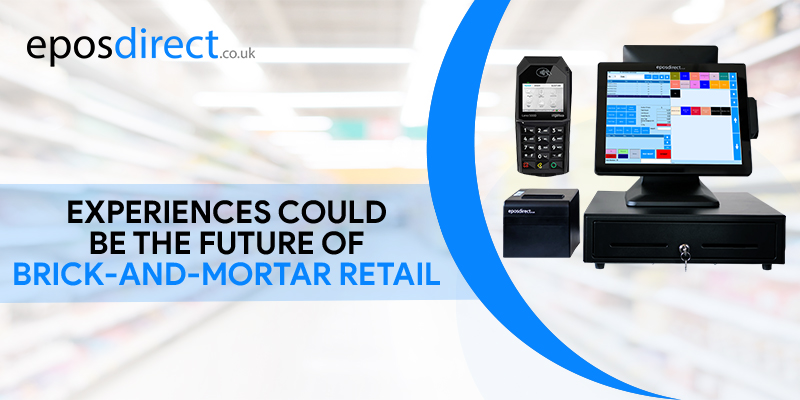We use cookies to make your experience better.
To comply with the new e-Privacy directive, you agree to the privacy policy and our use of cookies
Experiences Could Be the Future of Brick-And-Mortar Retail
As consumers shift toward online shopping, brick-and-mortar stores must reshape their business strategies to meet modern demands. To encourage customers to shop in-store, retailers must first reassure them that doing so will protect their health and safety.
E-commerce sites such as Amazon continue to demonstrate that physical locations are not required for businesses today. For Online surpassed in-store purchases for the first time, demonstrating how the internet is transforming the retail industry. In this article, we'll show you how your physical location can fit into this online-driven world by providing a contactless and yet complete experience.
What is Brick-And-Mortar?
The term "brick-and-mortar" refers to retailers who have at least one physical location. Brick-and-mortar businesses allow customers to shop with all of their senses rather than relying solely on images and descriptions. Department stores, supermarkets, beauty parlours, restaurant chains, and the ultramodern Apple stores in your local malls are examples of this type of retailer.
Brick-and-mortar retail stores were the way to conduct business. Customers come to the store, select the items they want, and a store employee assists and complete the transaction. While traditional brick-and-mortar stores are frequently pitted against online stores, this does not mean that businesses are limited to either online or offline channels. As such, the rise of e-commerce, and, more specifically, mobile commerce, has made a multiple channel business strategy more important than ever for retail stores.
Brick-and-mortar stores may have their roots in traditional building materials, but if tradition is your only foundation, your business will crumble as the marketing landscape shifts. Merging online and offline strategies is essential for maintaining your company's growth.
The following are the five key elements that define a brick-and-mortar store:
Inventory that is visible and physically accessible.
Promotional displays stand alone and are sometimes interactive.
Staff who are willing to assist customers during their shopping experience
Signboards and a physical layout are used to keep customers interested and moving forward.
An environment that reflects the store's brand.
Today's brick-and-mortar stores frequently do more than sell products. Customers expect retail stores to provide them with one-of-a-kind, branded experiences.
The Benefits of Brick-and-Mortar Shopping
The modern consumer still prefers to see and touch a variety of products before making a purchase. Allowing this reduces customer hesitancy and encourages them to be more deliberate in their purchases.
Personal assistance from the in-store staff is what brick-and-mortar customers want. Direct service generates more revenue — as well as more opportunities to upsell or cross-sell to them.
Buying in a well-run brick-and-mortar store is usually easier than buying online.
Customers who shop in stores buy something and take it home right away. This is extremely helpful. Ecommerce customers must wait for their orders to be delivered, which is why eCommerce companies are racing to offer next-day delivery.
Shipping and fulfilment costs are significantly lower in brick-and-mortar stores. You have no control over a product once it has been sold.
A physical store can provide your customers with unique, branded experiences. A lot of times, live experiences can't be replicated online.
In contrast, you can bring your brand's digital experiences to life in your physical store. Alternatively, offer the online store at a POS system.
Point-of-Sale (POS) Software for Brick-and-Mortar Stores
Point-of-Sale (POS) software is a critical component of a brick-and-mortar team's technology stack. The POS system in a store serves as its digital hub, facilitating the following processes.
Customer transactions: Employees complete purchases, returns, and exchanges directly through the store's POS system.
Sales reporting and analytics: POS tools collect transactional data for sales reporting and analytics. It provides information about the store's financial performance.
Inventory management: As inventory moves from storage to display shelves to the customer, it is recorded in the POS.
Employee management: Employee hours and on-the-job performance are tracked by POS systems.
Point-of-sale systems frequently support payment options. Mobile payments, PayPal, credit cards, and other traditional payment methods are accepted by modern POS systems.
What makes brick-and-mortar stores successful with Experiences?
Knowing how to drive internet-savvy shoppers to check out and provide the best customer experience possible is a huge element of staying competitive in the present world.
We'll go over some communication strategies you can use to boost customer satisfaction in your brick-and-mortar store and move shoppers along the buyer's journey.
Help customers reach out
The internet has provided customers with a lot of control over their own shopping experiences. As a result, buyers expect to be able to initiate conversations with businesses at their leisure.
Customers should easily contact you through your website if you provide a variety of contact options. This could include a phone number, an email address, and a contact form. We also recommend implementing a comprehensive chat tool that allows visitors to contact you from any page. It will enable you to capture leads better and communicate with them through an even more convenient channel: SMS.
Engaging customers on your social media channels is also a great way to build relationships through two-way conversation, even before they visit you in-store.
Response time
Make sure you have a consistent process in place for responding to customers across all channels, including online reviews. This procedure should specify who must respond and when and guidelines for how the response should appear. As a result, whenever your customers contact you, they will receive a consistent and seamless interaction.
Streamline your messages from every channel, so you never forget to respond if you want to centralize all of your interactions.
Lead customers to your store
As you build a relationship with your customer, the next step is to encourage them to visit your store. By directing users to your store, you will be able to use in-store marketing tools such as displays and a showrooming strategy to encourage customers to check out and purchase additional items.
To drive customers to your store, use digital marketing strategies such as social media, email, and SMS marketing to redirect the conversation to why they should visit you. A clothing brand, for example, may follow up on a lead by promoting an in-store exclusive sale.
In-store availability
When your customer arrives at your physical location, their experience should be no less convenient. Your team members should be present on the floor, ready to answer questions, provide a friendly face, and assist customers as needed. You can also install methods for customers to easily contact you for help, such as a call button that alerts your employees.
Some businesses even allow customers to live chat with them online while shopping in-store. For example, you can offer free WiFi in conjunction with a landing page that directs customers to your website, social media channel, or app—wherever you have chat functions.
Your communication strategy should also consider how your team members can stay connected on the floor to make your in-store experience as efficient as possible.
Following up
The conclusion of your in-store shopping trip does not have to be the conclusion of your conversation with your customer. After a customer makes a purchase, you can redirect them to your online channels in the hopes that they will return to your store. To keep your customer interested, thank them for their visit, offer a discount for their next in-store visit, or recommend products based on their purchase.
Going above and beyond in-store communication after the first visit is a great way to turn your current customers into loyal customers.
Streamline your communications
Brick-and-mortar stores aren't going away, but the brands that survive will be those that adapt to a technologically advanced world. As more consumers engage with brands and begin the customer journey through digital channels, you must ensure that you are open to in-store and online communication. Customers want convenience, so you must be available whenever and wherever they require you.








